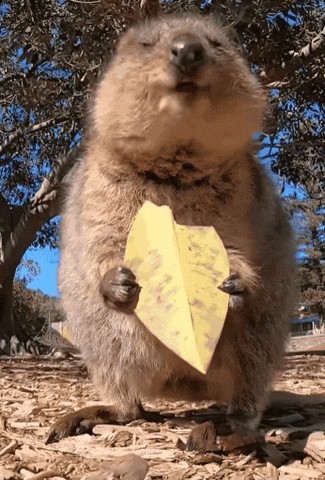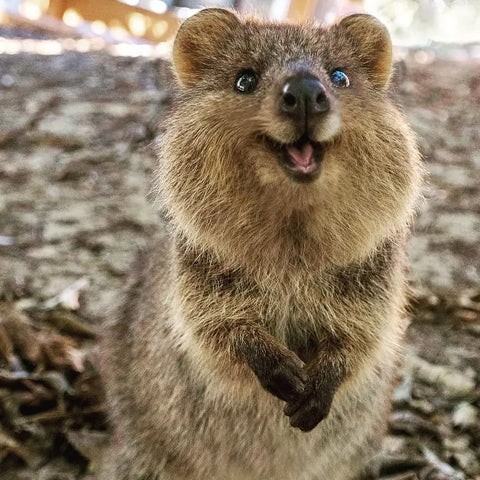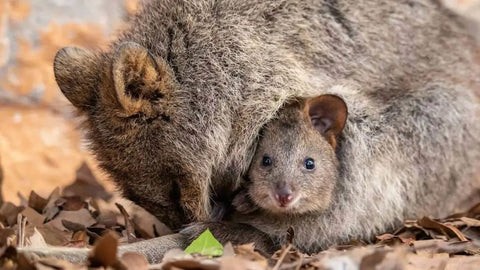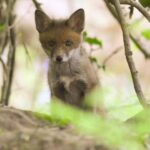Can Quokkas Be Kept As Pets?: Exploring Legalities and Care
Are you enchanted by the ever-smiling quokka and dreaming of having one as a pet? This question is one that PETS.EDU.VN frequently addresses, as these adorable marsupials capture the hearts of animal lovers worldwide. Let’s delve into the realities of quokka ownership, covering their conservation status, care needs, and legal restrictions. Discover why admiring these charming creatures in their natural habitat is the best way to appreciate them, and find alternative pet options that are both legal and fulfilling.
Table of Contents
- Understanding the Quokka: An Overview
- The Irresistible Charm of Quokkas
- Quokka Habitat: Where Do They Live?
- Quokka Diet and Lifestyle
- Quokka Social Behavior and Communication
- Quokka Reproduction and Development
- The Truth About Quokkas and Their Babies
- Quokka Conservation Status: An Endangered Species
- The Legality of Keeping Quokkas as Pets
- Reasons Why Quokkas Should Not Be Pets
- Ethical Considerations of Quokka Ownership
- The Importance of Conservation Efforts
- Alternatives to Quokka Ownership
- Caring for Native Australian Wildlife
- How to Help Quokkas in the Wild
- Quokka Tourism and Responsible Interactions
- The Future of Quokkas: Challenges and Hopes
- Where to Learn More About Quokkas
- Expert Advice on Wildlife Conservation
- Frequently Asked Questions (FAQ) About Quokkas
1. Understanding the Quokka: An Overview
The quokka (Setonix brachyurus) is a small macropod native to Western Australia, particularly Rottnest Island. These petite creatures, belonging to the kangaroo family, are known for their friendly appearance and adorable “smiling” faces. Quokkas typically measure between 40 to 54 cm in length, with a tail adding another 25 to 35 cm. They weigh between 2 and 5 kg, with males generally larger than females. Their sturdy hind legs enable them to hop efficiently, while their short, rounded ears contribute to their endearing look. The fur of a quokka is usually brown or grayish-brown on the back, transitioning to lighter shades on the belly. Learn more about the amazing Australian wildlife at PETS.EDU.VN.
2. The Irresistible Charm of Quokkas
Quokkas have captured global attention due to their seemingly perpetual smiles and approachable demeanor. Their facial structure, featuring a small, rounded face and high-set eyes, gives them a perpetually happy expression. When relaxed, their facial muscles naturally curve upwards, enhancing their smiling appearance. This, paired with their gentle nature, has earned them the title of “the happiest animal in the world.” Tourists flock to Rottnest Island for the unique opportunity to snap selfies with these friendly marsupials. PETS.EDU.VN highlights the importance of responsible interaction with wildlife, ensuring their safety and well-being.
3. Quokka Habitat: Where Do They Live?
Quokkas are primarily found in the southwestern region of Australia, particularly on Rottnest Island and in isolated mainland areas. Rottnest Island, near Perth, provides an ideal habitat with its diverse vegetation and ample food resources. Quokkas prefer dense undergrowth, grasslands, sandy dunes, and rocky terrains, often establishing their homes near water sources. These habitats provide them with the necessary shelter and sustenance. PETS.EDU.VN offers detailed information about various animal habitats and how to protect them.
4. Quokka Diet and Lifestyle
Quokkas are herbivores with a diet mainly consisting of various plant materials. They consume grasses, leaves, bark, and fruits, occasionally supplementing their diet with young shoots from bushes. They spend their days resting in shaded areas and foraging during the cooler hours of early morning and dusk. For shelter, quokkas dig burrows in the ground or seek refuge in rocky crevices. They also create simple shelters using available plant cover. For comprehensive guides on animal nutrition and care, visit PETS.EDU.VN.
5. Quokka Social Behavior and Communication
Quokkas typically live in small family units or groups led by adult females. Members of these units maintain close bonds, foraging, resting, and protecting their young together. Adult male quokkas establish and defend territories containing essential resources such as food and habitat. Quokkas communicate through a variety of methods, including body posture, vocalizations, and chemical signals. They express emotions through body language and use signals to warn of danger or attract mates. When threatened, they may display their teeth and adopt a defensive posture. In extreme situations, they use their powerful hind legs to escape. PETS.EDU.VN provides insights into animal behavior and social structures.
6. Quokka Reproduction and Development
Quokkas do not have a specific mating season and can reproduce throughout the year. Female quokkas usually produce one or two offspring annually. Male quokkas compete for territory and display to attract females. After a gestation period of approximately 25 days, the young quokka, known as a joey, is born. The joey develops in its mother’s pouch for about six months, where it nurses and receives protection until it is ready to leave the pouch. Female quokkas possess two uteruses and can pause the development of fertilized eggs, ensuring a continuous cycle of reproduction. This biological adaptation is crucial for their survival in fluctuating environmental conditions. PETS.EDU.VN offers extensive resources on animal reproduction and development.
7. The Truth About Quokkas and Their Babies
There is a widely circulated myth that quokkas intentionally “throw” their babies at predators as a defense mechanism. While dramatic, this is a misunderstanding. When a quokka mother feels threatened, her pouch muscles may relax, causing the joey to fall out. The joey’s cries can distract the predator, giving the mother a chance to escape. Researchers believe this involuntary expulsion is a survival strategy, not an intentional act of sacrifice. Additionally, quokkas have the unique ability to carry a “spare” embryo in their uterus, ready to develop if the current joey does not survive. PETS.EDU.VN is dedicated to dispelling myths and providing accurate information about animal behavior.
8. Quokka Conservation Status: An Endangered Species
Quokkas are currently listed as “vulnerable” by the International Union for Conservation of Nature (IUCN). Their population has declined due to several factors, including predation by introduced species such as cats, foxes, and dogs, habitat destruction from human activities, and wildfires. Conservation efforts include establishing nature reserves and wildlife sanctuaries to provide safe habitats and reduce human disturbance. Control programs are also in place to manage populations of introduced predators. With ongoing conservation efforts, there is hope that quokkas can thrive in their natural environment for generations to come. PETS.EDU.VN supports and promotes wildlife conservation initiatives.
9. The Legality of Keeping Quokkas as Pets
It is illegal to keep quokkas as pets in Australia. Quokkas are a protected species under the Perth Rottnest Island Authority Act of 1987. This legislation aims to protect quokkas from exploitation and ensure their survival in the wild. Penalties for illegally keeping quokkas can be severe, including hefty fines and potential imprisonment. The legal protection of quokkas is crucial for maintaining their population and preserving their natural habitat. PETS.EDU.VN emphasizes the importance of respecting wildlife laws and regulations.
10. Reasons Why Quokkas Should Not Be Pets
Keeping quokkas as pets is not only illegal but also detrimental to their well-being. Quokkas have specific dietary and environmental needs that are difficult to replicate in a domestic setting. In captivity, they may suffer from stress, malnutrition, and disease. Additionally, removing quokkas from their natural habitat disrupts their social structures and contributes to the decline of their wild populations. Quokkas belong in the wild, where they can thrive in their natural environment. PETS.EDU.VN advocates for the ethical treatment of animals and supports conservation efforts.
Here is a table summarizing the reasons why Quokkas should not be kept as pets:
| Reason | Explanation |
|---|---|
| Legal Protection | Quokkas are a protected species under Australian law, making it illegal to keep them as pets. |
| Specific Dietary Needs | Quokkas require a specialized diet of native plants, which is difficult to replicate in a domestic environment. |
| Environmental Requirements | Quokkas need a specific habitat with dense vegetation and access to natural resources, which is hard to provide in a typical home. |
| Social Disruption | Removing quokkas from their natural social groups can cause stress and disrupt their natural behaviors. |
| Stress and Health Issues | Captivity can lead to stress, malnutrition, and increased susceptibility to diseases, negatively impacting their overall well-being. |
| Conservation Concerns | Keeping quokkas as pets contributes to the decline of their wild populations and undermines conservation efforts. |
| Ethical Considerations | It is unethical to deprive a wild animal of its natural habitat and freedom for personal enjoyment. |
| Impact on Wild Populations | Removing quokkas from the wild can have a negative impact on the genetic diversity and overall health of wild populations. |
| Complex Behavioral Needs | Quokkas have complex behavioral needs that cannot be met in a domestic setting, leading to abnormal behaviors and reduced quality of life. |
| Public Health and Safety Risks | Wild animals can carry diseases that can be transmitted to humans, posing a risk to public health and safety. |




11. Ethical Considerations of Quokka Ownership
The ethical implications of keeping quokkas as pets extend beyond legal considerations. Wild animals, including quokkas, have the right to live freely in their natural habitats. Removing them from the wild for personal enjoyment is a form of exploitation that deprives them of their natural behaviors and social interactions. Ethical pet ownership involves choosing animals that are suited to domestication and can thrive in a domestic environment. Quokkas, as wild animals, are not suited to life as pets. PETS.EDU.VN promotes ethical pet ownership and responsible interactions with wildlife.
12. The Importance of Conservation Efforts
Conserving quokkas and their habitats is essential for maintaining biodiversity and preserving Australia’s natural heritage. Conservation efforts include habitat restoration, predator control, and public education. Supporting these initiatives helps ensure that quokkas can continue to thrive in the wild. By protecting quokkas, we also protect the ecosystems they inhabit, benefiting countless other species. PETS.EDU.VN provides resources and information on how to support wildlife conservation efforts.
Here’s a table outlining the key conservation efforts aimed at protecting Quokkas:
| Conservation Effort | Description |
|---|---|
| Habitat Restoration | Restoring and maintaining the natural habitats of quokkas, including dense vegetation and access to water sources, ensures they have the resources they need to thrive. |
| Predator Control | Managing and controlling populations of introduced predators like foxes, cats, and dogs helps reduce the threat to quokka populations. This can involve trapping, fencing, and other methods to protect quokkas from predation. |
| Public Education | Educating the public about the importance of quokka conservation and responsible tourism practices helps raise awareness and encourages people to take action to protect these animals. This can include providing information on how to interact with quokkas safely and respectfully. |
| Establishing Protected Areas | Creating nature reserves and wildlife sanctuaries provides safe havens for quokkas, where they are protected from human disturbance and other threats. These areas can also serve as research sites for studying quokka behavior and ecology. |
| Disease Management | Monitoring and managing diseases that can impact quokka populations is essential for maintaining their health and resilience. This can involve vaccination programs, disease surveillance, and quarantine measures to prevent the spread of diseases. |
| Research and Monitoring | Conducting ongoing research to better understand quokka behavior, ecology, and threats helps inform conservation strategies and management decisions. Monitoring quokka populations over time allows researchers to track their numbers and identify any potential issues that need to be addressed. |
13. Alternatives to Quokka Ownership
While you cannot keep a quokka as a pet, there are many other animals that make wonderful companions. Consider adopting a domesticated pet such as a dog, cat, or rabbit. These animals have been bred for companionship and are well-suited to life in a domestic environment. Responsible pet ownership involves providing proper care, nutrition, and enrichment to ensure your pet’s well-being. PETS.EDU.VN offers comprehensive guides on caring for a variety of pets.
14. Caring for Native Australian Wildlife
If you are passionate about Australian wildlife, there are many ways to get involved in their care and conservation. Consider volunteering at a local wildlife rescue organization or donating to conservation charities. You can also support sustainable tourism practices that protect native habitats. By taking action to protect Australian wildlife, you can make a positive impact on their future. PETS.EDU.VN provides resources and information on how to get involved in wildlife conservation.
15. How to Help Quokkas in the Wild
There are several ways you can contribute to the conservation of quokkas in their natural habitat:
- Support Conservation Organizations: Donate to or volunteer with organizations dedicated to quokka conservation.
- Practice Responsible Tourism: When visiting quokka habitats, follow guidelines to minimize disturbance and avoid feeding them.
- Educate Others: Share information about quokkas and the importance of their conservation with friends, family, and online communities.
- Reduce Your Environmental Impact: Support sustainable practices that protect natural habitats and reduce pollution.
By taking these steps, you can help ensure the survival of quokkas in the wild. PETS.EDU.VN offers additional resources and tips on how to support wildlife conservation efforts.
16. Quokka Tourism and Responsible Interactions
Quokka tourism on Rottnest Island provides economic benefits for the local community, but it’s important to interact with these animals responsibly. Avoid feeding quokkas human food, as it can harm their health and alter their natural behaviors. Maintain a respectful distance and avoid touching or handling them. By following these guidelines, you can enjoy observing quokkas in their natural environment without causing them harm. PETS.EDU.VN promotes responsible tourism practices that protect wildlife and their habitats.
17. The Future of Quokkas: Challenges and Hopes
The future of quokkas depends on continued conservation efforts and addressing the threats they face. Climate change, habitat loss, and introduced predators remain significant challenges. However, with increased awareness, dedicated conservation programs, and community involvement, there is hope that quokkas can thrive for generations to come. PETS.EDU.VN remains committed to providing information and resources to support quokka conservation and other wildlife initiatives.
18. Where to Learn More About Quokkas
To deepen your understanding of quokkas and their conservation, explore these resources:
- The Rottnest Island Authority: Offers information about quokkas and responsible tourism on Rottnest Island.
- The Department of Biodiversity, Conservation and Attractions (DBCA): Provides details on conservation efforts in Western Australia.
- The International Union for Conservation of Nature (IUCN): Features the latest conservation status and information on quokkas.
- PETS.EDU.VN: A comprehensive resource for information on various animals, including their habitats, behaviors, and conservation status.
19. Expert Advice on Wildlife Conservation
For expert advice on wildlife conservation, consider these tips from professionals in the field:
- Support Local Initiatives: Get involved with local conservation groups and projects in your area.
- Advocate for Policy Changes: Support policies that protect wildlife habitats and promote sustainable practices.
- Educate Yourself: Stay informed about conservation issues and share your knowledge with others.
- Reduce Your Carbon Footprint: Take steps to minimize your environmental impact and support a healthier planet for all species.
20. Frequently Asked Questions (FAQ) About Quokkas
Q1: Are quokkas endangered?
A: Quokkas are classified as vulnerable, which means they face threats to their survival in the wild.
Q2: Can I keep a quokka as a pet in the United States?
A: No, quokkas are native to Australia and are protected by Australian law, making it illegal to keep them as pets anywhere.
Q3: What do quokkas eat?
A: Quokkas primarily eat grasses, leaves, bark, and fruits.
Q4: Where do quokkas live?
A: Quokkas mainly live in the southwestern region of Australia, particularly on Rottnest Island.
Q5: How can I help quokkas?
A: You can help quokkas by supporting conservation organizations, practicing responsible tourism, and educating others about their importance.
Q6: Why are quokkas called the happiest animal in the world?
A: Quokkas have a facial structure that gives them a perpetually smiling appearance, contributing to their reputation as the happiest animal.
Q7: Do quokkas really throw their babies at predators?
A: This is a misunderstanding. When threatened, a quokka mother’s pouch muscles may relax, causing the joey to fall out, distracting the predator and allowing the mother to escape.
Q8: What threats do quokkas face?
A: Quokkas face threats from introduced predators, habitat loss, and climate change.
Q9: Can quokkas reproduce year-round?
A: Yes, quokkas do not have a specific mating season and can reproduce throughout the year.
Q10: What should I do if I see someone harming a quokka?
A: Report the incident to local wildlife authorities immediately.
We hope this article has provided you with a comprehensive understanding of quokkas and the reasons why they should not be kept as pets. At PETS.EDU.VN, we are dedicated to providing accurate and informative content about animals and their conservation. Remember, admiring and supporting these wonderful creatures in their natural habitat is the best way to ensure their survival.
For more information about wildlife conservation and responsible pet ownership, visit PETS.EDU.VN.
Contact Information:
- Address: 789 Paw Lane, Petville, CA 91234, United States
- WhatsApp: +1 555-987-6543
- Website: pets.edu.vn
